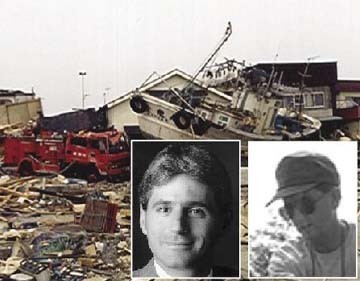
Professors study tsunami (Photo by Jane Preuss, Urban Planner)
Mother nature creates, nourishes and destroys. On Dec. 26, 2004, the world felt the impact of Mother Nature in her deadliest form yet this century: a 9.0-magnitude earthquake that generated a deadly tsunami.
Without warning, citizens of Indonesia, Thailand, Sri Lanka, India, and other Asian countries were left at the mercy of the Indian Ocean, leaving many questioning what can be done to prevent future tsunami disasters.
Tsunami expert Peter Raad and geologist Brian Stump, both SMU professors, provide outlooks, warnings, outline effective alert systems and name a vulnerable stretch of U.S. coastline.
Currently teaching an undergraduate introductory course titled “Volcanoes and Earthquakes,” Stump’s subject does not achieve national headlines often.
“It’s right now the biggest earthquake of my career,” Stump said.
And from a research and development standpoint, Stump said its effects will only aid to the advancement of urban planning and engineering to withstand the forces of tsunamis caused by earthquakes of this severe magnitude.
“Advancements will be made in how we build buildings, where we build buildings and how we might evacuate those areas,” Stump said. “[Devastating weather] events will occur and reoccur.”
Stump names the Oregon-Washington coastline as the most likely location of an U.S. tsunami.
“It will happen, the question is when,” Stump said. He added that only time and the advancement of geological research could predict such an event.
Raad, a tsunami expert source for media outlets such as CNN, The National Geographic Channel, The Washington Post and The New York Times, said knowledge and communication are keys to saving lives in the event of a tsunami.
“Knowledge is important, but dissemination of knowledge is extremely important,” Raad said.
He then listed four stages of an efficient and effective alert system, adding that any break in the chain of the communication could lead to disaster:
1. Get information to the proper authorities.
2. Authorities need to have a plan.
3. Need to have proper communication system for the people.
4. People need to be educated as to what they need to do.
Raad also issued some advice in surviving an oncoming tsunami.
He cautioned against taking a boat out to sea to flee from an earthquake’s shockwaves. If a tsunami develops off shore while a person is escaping by boat, the likelihood of avoiding the lethal waves is slim.
One of the warning signs Raad said is most noticeable is if the tide begins to recede. If that happens those on the beach should run inland. Raad estimated that a person has 10 to 20 minutes before being swallowed by the ocean.
To give coastline residents the highest chance to survive a tsunami, Stump expressed the need for efficiency in the current alert systems around the world to help avoid disasters like Dec. 26.
“The aftermath of this tsunami illustrates that we need to understand these things to develop a better warning system,” Stump said.









